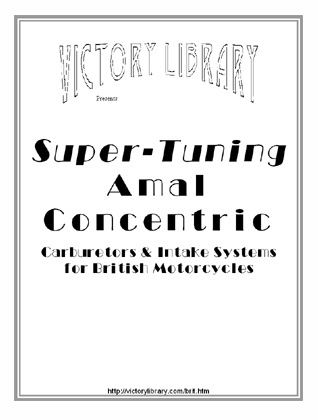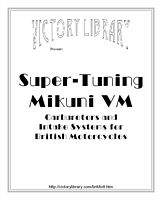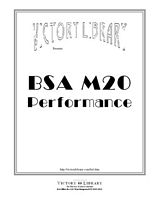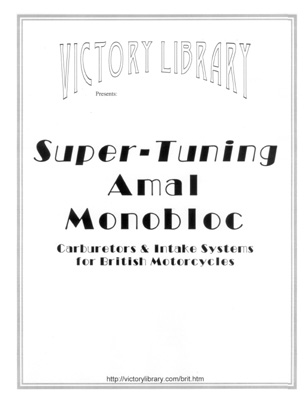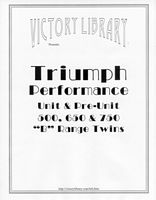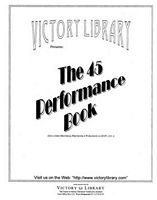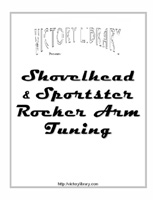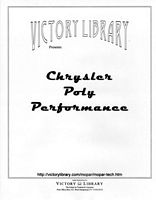|
|  |
What is “tuned exhaust”?
The concept is fairly well known: the energy carried by exhaust gas pressure in the pipe can be made to perform useful work in removing residual exhaust gas from the combustion chamber, and inducing a fresh intake charge to enter before engine vacuum takes over. This occurs during the “overlap” period around TDC (“Top Dead Center”, 360° or one engine rotation from the beginning of the power stroke), when both intake and exhaust valves are (partially) open.
Only engines with sufficient overlap built in to their cam design can benefit from this form of tuning. The overlap threshold (mimimum) will vary with combustion chamber design, compression ratio, valve sizes, peak power RPM, port efficiency, &c. If the cam is too mild (has a brief overlap period) this will not work, and the most efficient exhaust system is the biggest valve and the biggest pipe you can fit, since the resultant reduced pumping loss is the only remaining benefit.
The energy is a change in gas pressure in the exhaust pipe caused by how the engine functions, and how and when the gas is released into another environment, which need not be open air. A positive pulse of exhaust gas pressure expanding into a pipe of substantially (20%) larger diameter, or into the conical diffusor of a megaphone, or into the atmosphere reflects back into the pipe as a negative (reversed) wave; a positive pulse striking a solid surface reflects back into the pipe as a positive wave. The “tuning” is the arrangement of the pipe diameter, length and shape to cause this pressure change to occur at the moment of greatest use to the engine designer.
The strongest negative pressure wave return is produced by a straight open pipe with the end cut off at 90° to the flow axis. It’s easy to make, light, easy to adjust, easy to calculate, and has great ground and chassis clearance. However, there are problems that make it a compromise rather than the best choice:
1. there is a return pulse that completely confuses the main nozzle (viz. the needle jet or emulsion tube) somewhere between 3,500-4,000 RPM and makes accurate carburetor jetting nearly impossible.
2. the power boost at the tuned RPM is fairly strong, but it’s a very narrow range of engine speed (only a few hundred RPM).
| Calculating the Primary Pipe Size
In my opinion, there is a minimum gas density (in molecules per cubic inch) needed to transmit the wave energy efficiently, or the pulse strength is reduced. If the pipe ID is too big the power will go up slightly due to lower pumping losses, but the evacuation effect at overlap will fade out, resulting in a net loss. The minimum exhaust density is unfortunately beyond my ability to calculate, since the gas flow isn’t continuous, and varies by valve size, rod ratio, compression ratio, VE, etc.
The Table below calculates gas speed at 300 f/s at peak power. The sizes are adjusted to allow for standard 18 gauge tubing with .049” wall, so the size shown is the OD. An additional correction has been made for “Poiseville” flow. This refers to the fact that no flow takes place at the inner wall of the pipe ID, and very little immediately adjacent to it. In this Table, 1mm (.03937”) has been subtracted from the ID of the calculated pipe sizes.
Be realistic - peak power at 9,000 RPM will make the bike impossible to ride. Note that 1½” pipe is large enough for a 750 @ 7,800 RPM, a Gold Star can do quite well at 7,000 RPM with 1-5/8”, and 1¼” matches 8,000 RPM for a 750 triple.
The argument against a straight pipe is that the tuned RPM is instant (“the wave return has maximum amplitude, but the frequency is very narrow”).
IMHO practical experience proves this to be inaccurate to some extent with most engines using some degree of serious overlap. I think what’s happening is that the usual RPM + exhaust opening point-based calculation is keyed to the wave arriving at TDC (which always happens during the tuned period).
However: this may not be the center of the overlap triangle (certainly not if the overlap isn’t “split”, viz. evenly disposed by degrees B & ATDC). It’s also not the only point where a strong vacuum pulse will increase charge weight and VE - this will occur (to a greater or lesser degree) at any point when both valves are open (the entire overlap window), but of course limited by the minimum lift needed to expose the chamber to either the exhaust pulse or the intake port - which are probably slightly different).
With high overlap, this means that an effective pulse arrives during a much wider RPM range than the simple calculation predicts.
Using nominal duration for all events, this adds up to 1,000 RPM on either side of the predicted tuned RPM; of course, the wave have far less effect when arriving with one valve at very low lift. The pulse amplitude in psi may be shaped roughly like the overlap triangle itself with a spike near maximum total of intake + exhaust lift during overlap, decaying in either direction (but perhaps not at the same rate), and positioned in similar fashion (viz., not necessarily @ TDC). |
Primary Pipe Size vs. RPM |
Single | 175cc
| 250cc | 265cc | 300cc | 325cc | 350cc | 375cc |
400cc | 414cc | 425cc | 500cc |
Twin | 350cc
| 500cc | 530cc | 600cc | 650cc | 700cc | 750cc | 800cc | 828cc | 850cc | 1000cc |
4,000 | .76” | .90” | .92” | .98” | 1.02” | 1.05” | 1.09” | 1.12” | 1.14” | 1.15” | 1.25” |
4,250 | .78” |
.92” | .95” | 1.01” | 1.05” | 1.08” | 1.12” | 1.15” | 1.17” | 1.19” | 1.28” |
4,500 | .80” | .95” | .98” | 1.03” | 1.07” | 1.11” | 1.15” | 1.19” | 1.20” | 1.22” | 1.32” |
4,750 | .82” |
.97” | 1.00” | 1.06” | 1.10” | 1.14” | 1.18” | 1.22” | 1.24” | 1.25” | 1.35” |
5,000 | .84” | 1.00” | 1.03” | 1.09” | 1.13” | 1.17” | 1.21” | 1.25” | 1.27” | 1.28” | 1.39” |
5,250 | .86” | 1.02” | 1.05” | 1.11” | 1.16” | 1.20” | 1.24” | 1.28” | 1.30” | 1.31” | 1.42” |
5,500 | .88” |
1.04” | 1.07” | 1.14” | 1.18” | 1.22” | 1.26” | 1.30” | 1.33” | 1.34” | 1.45” |
5,750 | .90” |
1.07” | 1.10” | 1.16” | 1.21” | 1.25” | 1.29” | 1.33” | 1.35” | 1.37” | 1.48” |
6,000 | .92” |
1.09” | 1.12” | 1.19” | 1.23” | 1.28” | 1.32” | 1.36” | 1.38” | 1.40” | 1.51” |
6,250 | .94” | 1.11” | 1.14” | 1.21” | 1.26” | 1.30” | 1.34” | 1.39” | 1.41” | 1.43” | 1.54” |
6,500 | .95” | 1.13” | 1.16” | 1.23” | 1.28” | 1.33” | 1.37” | 1.41” | 1.44” | 1.45” | 1.57” |
6,750 | .97” | 1.15” | 1.18” | 1.25” |
1.30” | 1.35” | 1.39” | 1.44” | 1.46” | 1.48” | 1.60” |
Single | 175cc
| 250cc | 265cc | 300cc | 325cc | 350cc | 375cc |
400cc | 414cc | 425cc | 500cc |
Twin | 350cc
| 500cc | 530cc | 600cc | 650cc | 700cc | 750cc | 800cc | 828cc | 850cc | 1000cc |
7,000 | .99” | 1.17” | 1.20” | 1.28” | 1.33” | 1.37” | 1.42” | 1.46” | 1.49” | 1.51” | 1.63” |
7,250 | 1.00” | 1.19” | 1.22” | 1.30” | 1.35” | 1.40” | 1.44” | 1.49” | 1.51” | 1.53” | 1.66” |
7,500 | 1.02” | 1.21” | 1.24” | 1.32” | 1.37” | 1.42” | 1.47” | 1.51” | 1.54” | 1.56” | 1.68” |
7,750 | 1.04” | 1.23” | 1.26” | 1.34” | 1.39” | 1.44” | 1.49” | 1.54” | 1.56” | 1.58” | 1.71” |
8,000 | 1.05” | 1.25” | 1.28” | 1.36” | 1.41” | 1.46” | 1.51” | 1.56” | 1.59” | 1.61” | 1.74” |
8,250 | 1.07” | 1.26” | 1.30” | 1.38” | 1.43” | 1.49” | 1.54” | 1.58” | 1.61” | 1.63” | 1.76” |
8,500 | 1.08” | 1.28” | 1.32” | 1.40” | 1.45” | 1.51” | 1.56” | 1.61” | 1.63” | 1.65” | 1.79” |
8,750 | 1.10” | 1.30” | 1.34” | 1.42” | 1.47” | 1.53” | 1.58” | 1.63” | 1.66” | 1.68” | 1.81” |
9,000 | 1.11” | 1.32” | 1.36” | 1.44” | 1.49” | 1.55” | 1.60” | 1.65” | 1.68” | 1.70” | 1.84” |
9,250 |
1.13” | 1.34” | 1.37” | 1.46” | 1.51” | 1.57” | 1.62” | 1.67” | 1.70” | 1.72” | 1.86” |
9,500 | 1.14” | 1.35” | 1.39” | 1.48” | 1.53” | 1.59” | 1.64” | 1.70” | 1.72” | 1.75” | 1.89” |
9,750 | 1.16” | 1.37” | 1.41” | 1.49” | 1.55” | 1.61” | 1.66” | 1.72” | 1.75” | 1.77” | 1.91” |
Single | 175cc
| 250cc | 265cc | 300cc | 325cc | 350cc | 375cc |
400cc | 414cc | 425cc | 500cc |
Twin | 350cc
| 500cc | 530cc | 600cc | 650cc | 700cc | 750cc | 800cc | 828cc | 850cc | 1000cc |
A megaphone (single-taper cone) trades gas pulse strength for RPM range - the pressure drop is lower, but lasts longer. It also gives a return wave at bad times, is more difficult to make, heavier, very difficult to adjust (the primary length is the only practical adjustment), complex to calculate, and has bad ground and chassis clearance.
Megaphones have been tried by most British twin owners since perhap 1960, when they were visible on many IOM bikes, especially the Manx, etc.
A major reason why results for megs are difficult to analyze and don’t show a clear pattern is something 2-stroke owners have known for 40 years: the carburetor signal doesn’t change when the wave returns, so the VE increases, cylinder pressure goes up, etc. but mixture doesn’t change, and the engine seizes. This was why Jennings advised not using the strongest returning wave (viz. use a 6° taper rather than a 9°): the carburetor will be “less wrong” at that point, and less likely to seize.
A reverse-cone for a 4-stroke has a similar (but smaller) problem: there’s no way to get a mixture adjustment for the change in breathing when the wave returns, except by changing the size and position (height in the well) of the intermediate air bleed corresponding to that specific engine size, RPM, throttle opening etc. This is especially fun when this circuit doesn’t exist on your carby, and you have to make one...
Many have tried megs and found a little power but too much trouble to use, some haven’t even gotten that, but as factories (Honda) have shown, a reverse cone is the fastest set-up even for a multi - yes, faster than a collector.
Walter Kaaden, generally credited as the father of the expansion chamber, once remarked “You’ll know when you have the design right, because the chamber will then be impossible to fit on the motorcycle without having it drag the ground, burn the rider’s leg, or force the relocation of one or more major components” (quoted by Gordon Jennings).
Single-cylinder 4-stroke race motors have relied on megaphones as the most efficient exhaust system for over 50 years. The tapered cone is actually a “diffusor” or expansion chamber with a divergent area, with increasing area from the inlet (the end of the primary exhaust pipe) to its maximum size (about 625% of the primary pipe area).
A reverse cone megaphone adds a “baffle” or convergent area cone as a method of improving mid-range at the expense of some peak power by increasing velocity at the exit. Baffle sizes provide another adjustment (smaller exit = better mid-range).
With one cylinder the megaphone is generally fastest where any power range is needed.
With two cylinders it’s still a question whether a 2-1 (or 2-1-2 as used by Norton and Ducati) is preferable to 2 megaphones.
Three or more cylinders: header(s) and collector.
One of the advantages of a megaphone over a simple open pipe is that the “boom” of the open pipe (the sudden, explosive gas pressure release reflecting a negative wave back up the pipe) is instantaneous: the dispersal is right to ATM (atmospheric pressure)in 1 shot, so that the amplitude (pulse strength, in psi) of the pressure wave is high, but the duration (in milliseconds or degrees of engine rotation) is very brief, and hard to tune for.
A taper of any kind expands the gas much more slowly (reduced amplitude pressure change) but since the shallow taper is very long, the tuned length(s) of the pipe is from every spot on the taper back up to the valve, a much wider range. A sharp (steep) taper (9° angle) produces a very strong pulse, short pipe, narrow torque range, hard to jet for. Sharper than 9° narrows the RPM range enough to be impractical. A more shallow taper (5°) produces a weaker pulse over a wider range. Below 4°, the expansion pulse is so weak as not to help, plus the length of the cone reaches beyond the wheel. 7-8° included beginning with 1½” OD and ending when it reaches 3 to 3½” taper (bigger = more power), then a 14-20° (about 2 ´ primary taper) reverse with a small exit works pretty well on any mid size motor, and can be tuned a bit on the spot by splicing or removing small sections (1 to 2”) of 1½” from between the head pipe and meg entry. Also allows balance between top end vs. range by substituting different reverse cone ends - 2½” open is full power, 1-3/4” much tamer, etc. Look at some XR750 stuff to see development work on a meg. Really fine tuning changes the taper of the reverse, uses stepped primaries, multiple tapers, re-entrant primary pipe, etc. but only small improvements and must be done to suit the individual motor - dyno.
The usual (Bell etc.) math suggests that the primary length is whatever is left over after calculating the diffuser specs, either based on maximum OD (3-4”) or taper (14-20° included angle) and subtracting them from the tuned length (based on RPM, gas speed, exhaust duration, etc.). The baffle (reverse cap) appears to be less sensitive and no real details are given, it’s an afterthought. Might this be why the tuning instructions frequently say “begin with a primary length 2-4” longer than your predicted length and shorten by test; some adjustments to the primary length may be needed”.
Vizard insists that this allows the primary to be larger to increase peak power (raises peak torque by 500 RPM per 1/8” or so).
I’m not sure this is always true.
The primary length (valve seat to diffuser entry) is the the calculated length based on the highest RPM at which you think the engine has enough VE to produce useful power.
One reason why cones vary between engines isn’t the engine at all - but the transmission and the race itself.
The total length to the end of the diffuser cone is the lowest RPM you need, probably close to the shift recovery point on the 2-3 3-4 or 4-5 shift (the 1-2 is typically widest, and relatively harmless). Obviously, road race transmission ratios will allow more RPM recovery than trials.
The length of the diffuser (megaphone) cone is the difference, and determines the RPM band.
The diffuser ID is (primary ID^2 × 6.25)^.5, using Blair’s guess that 625% extracts all useful wave energy based on common gas temp and press. E.g., 1-5/16” primary ID = 3.28” major ID; add for wall thickness to get OD. Larger does nothing useful (and weaken the pulse inside the cone), smaller leaves some power on the table.
The diffuser included angle is whatever it takes to make the cone (1.3125” > 3.28”).
If you try to extend the range too much, the angle gets so shallow that the return pulse has no “bang”.
Almost all cones use between 4° and 10° included angle, so they all look pretty much alike. Longer taper produces very weak wave and very long length; really big taper produces a stronger wave but so brief that little advantage over a straight pipe.
As Blair explains, any change in cross-section (taper, step, open end, reverse cap) produces another wave, and the superposition of waves in both directions, pressure changes, and local temperature changes, mean that:
1. formulas cannot be spot-on, not because the math is faulty, but because there is too much traffic
2. many of the “I did this, and it worked” (and the reverse) are the result of cumulative stacked errors in opposite directions canceling each other out (3 advantages + 2 mistakes = acceptable results, &c.), and result in no repeatable method.
Engines with big ports, long cam duration, and narrow RPM range can only use a high-taper megaphone if their internal ratios are very close (Gold Star: RR, RR.2). The similar Catalina would be almost unrideable using TRI. or STD. ratios, and so must use a longer primary and slower taper.
BSA’s insistence on using a huge pipe on the 500 was also, IMHO, a mistake and a major reason for the narrow power range - too much reversion, very sensitive to overlap.
They were also very careless of how small a discontinuity in the inner wall surface will induce a reflection - some of the welds and bends were terrible, and secondary, tertiary, blah waves probably occurred all the time and confounded the tuners (“that’s not supposed to happen when we do X”, &c.).
Unfortunately, any anti-reversion device (cone, step, saw-tooth) also induces a strong wave since it’s at the point of maximum instant pressure very close to the valve (Blair: exhaust pressure at the valve may be 6 or more times as strong as the mean pressure in the pipe).
The “ideal” (pure) mega exhaust has a continuous cross-sectional area with constant wall shape from the exhaust seat right to the diffuser entry. Anything else produces ghosts and shadows in the wave trace.
Just my opinion; examining a dyno plot for spikes and glitches:
A really ragged line in the torque band is good evidence of many pulse echoes (although some are merely multiples of intentional reflections).
How to tell these from that other menace - the bad fuel curve? Back off to 7/8 throttle, if it changes (good or bad) it was the emulsion tube/air correction. If not, it’s probably the exhaust (the intake will cause similar problems, but in miniature due to smaller forces at work).
|
Megaphone Taper vs. Length for Various Angles
|
Primary | 625% Primary Area | Length |
OD | ID, 18ga. | Area | ID, 18ga. | OD | 6° Taper | 7° Taper | 8° Taper | 9° Taper | 10° Taper |
1” | 1.000” | .902” | .639” | 2.255” | 2.353” | 6.44” | 5.51” | 4.81” | 4.27” | 3.84” |
1-1/8” | 1.125” | 1.027” | .828” | 2.567” | 2.666” | 7.33” | 6.27” | 5.48” | 4.86” | 4.37” |
1-1/4” | 1.250” | 1.152” | 1.042” | 2.880” | 2.978” | 8.22” | 7.04” | 6.15” | 5.46” | 4.90” |
1-5/16” | 1.313” | 1.215” | 1.158” | 3.036” | 3.134” | 8.67” | 7.42” | 6.48” | 5.75” | 5.17” |
1-3/8” | 1.375” | 1.277” | 1.281” | 3.193” | 3.291” | 9.11” | 7.80” | 6.81” | 6.05” | 5.43” |
1-7/16” | 1.438” | 1.334” | 1.409” | 3.349” | 3.447” | 9.56” | 8.18” | 7.15” | 6.34” | 5.70” |
1-1/2” | 1.500” | 1.402” | 1.544” | 3.505” | 3.603” | 10.00” | 8.56” | 7.48” | 6.64” | 5.96” |
1-5/8” | 1.625” | 1.527” | 1.831” | 3.818” | 3.916” | 10.90” | 9.33” | 8.15” | 7.23” | 6.50” |
1-3/4” | 1.750” | 1.652” | 2.143” | 4.130” | 4.228” | 11.79” | 10.09” | 8.82” | 7.82” | 7.03” |
1-7/8” | 1.875” | 1.777” | 2.480” | 4.443” | 4.541” | 12.68” | 10.85” | 9.48” | 8.41” | 7.56” |
2” | 2.000” | 1.902” | 2.841” | 4.756” | 4.853” | 13.57” | 11.62” | 10.15” | 9.01” | 8.09” |
|


